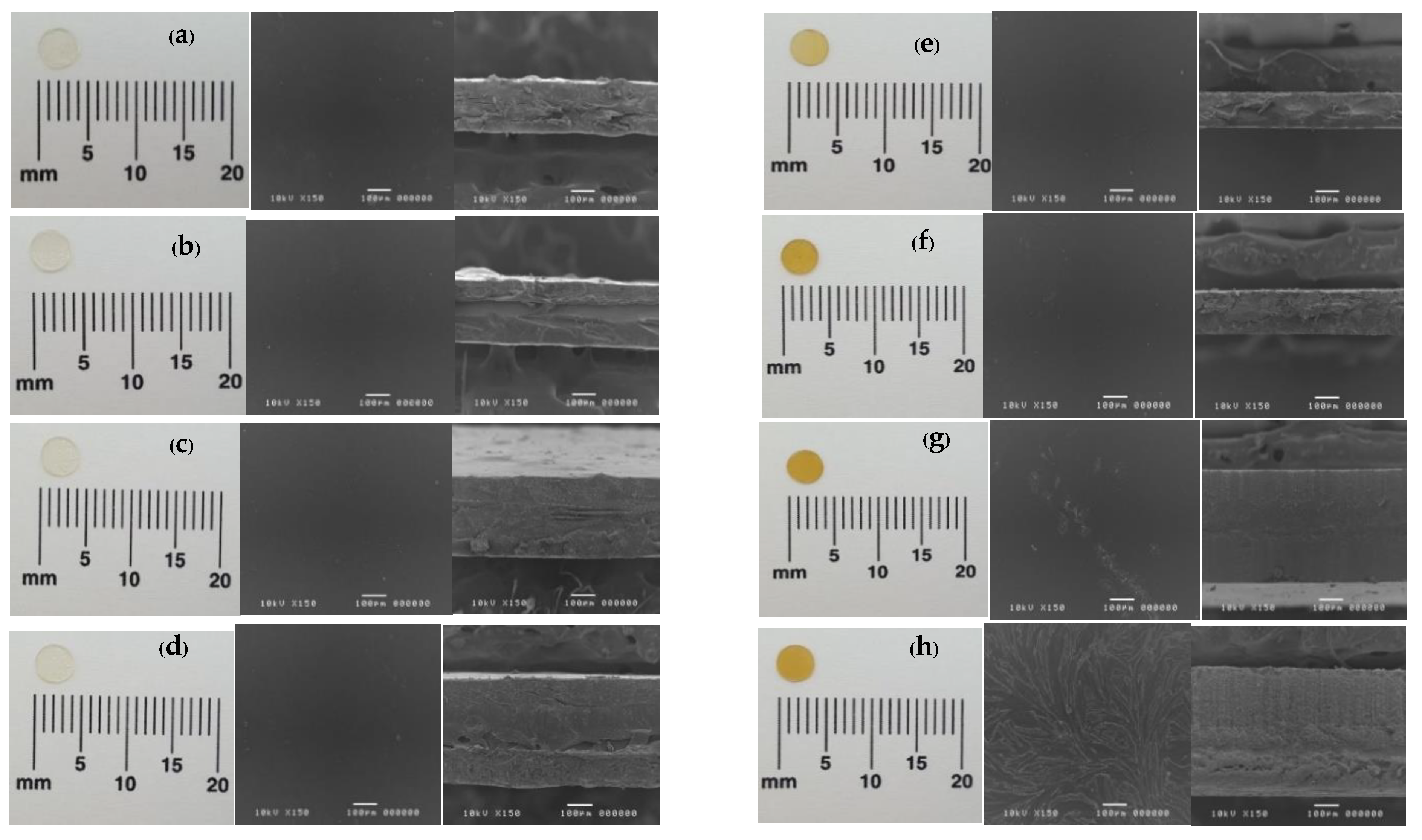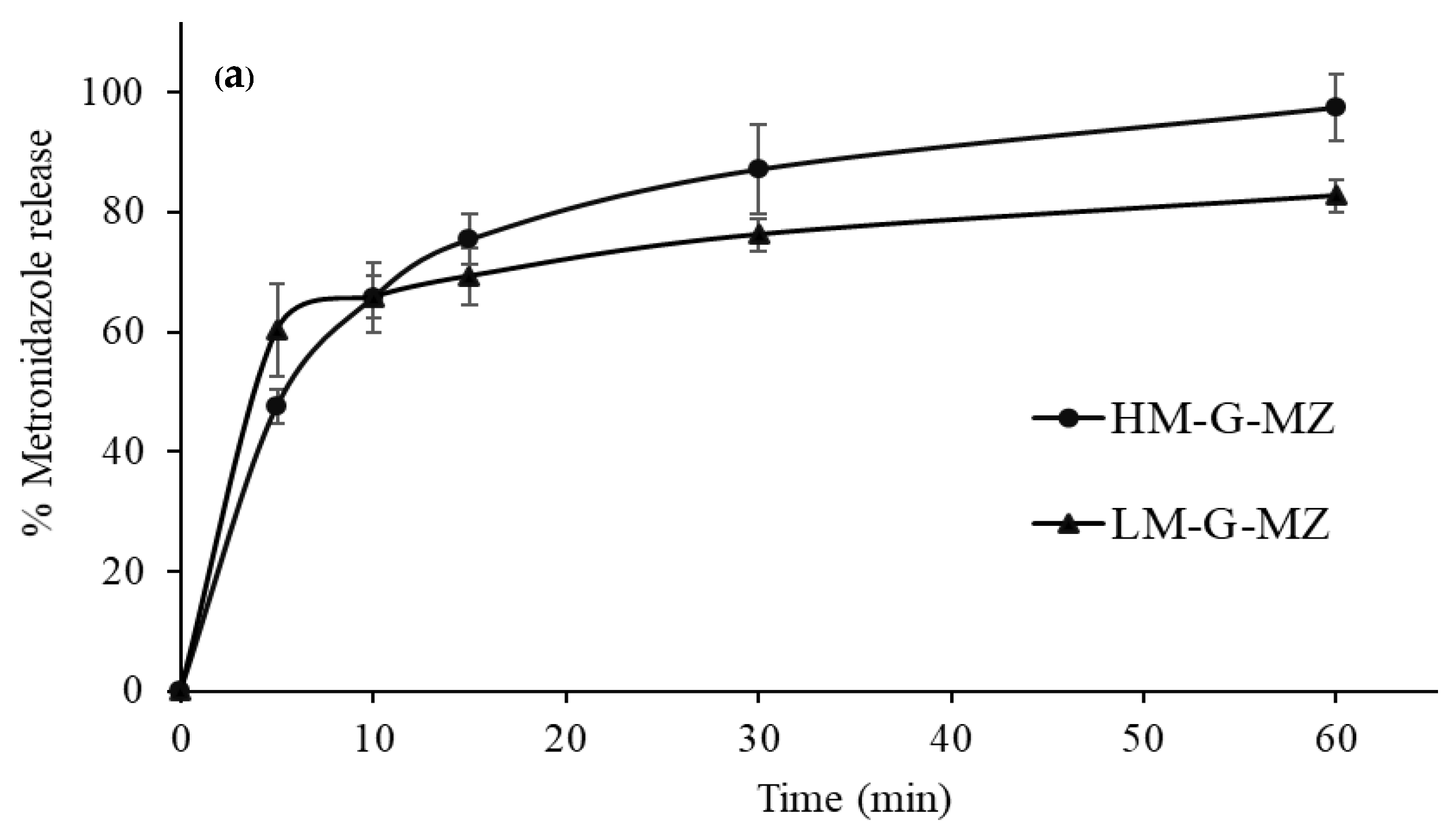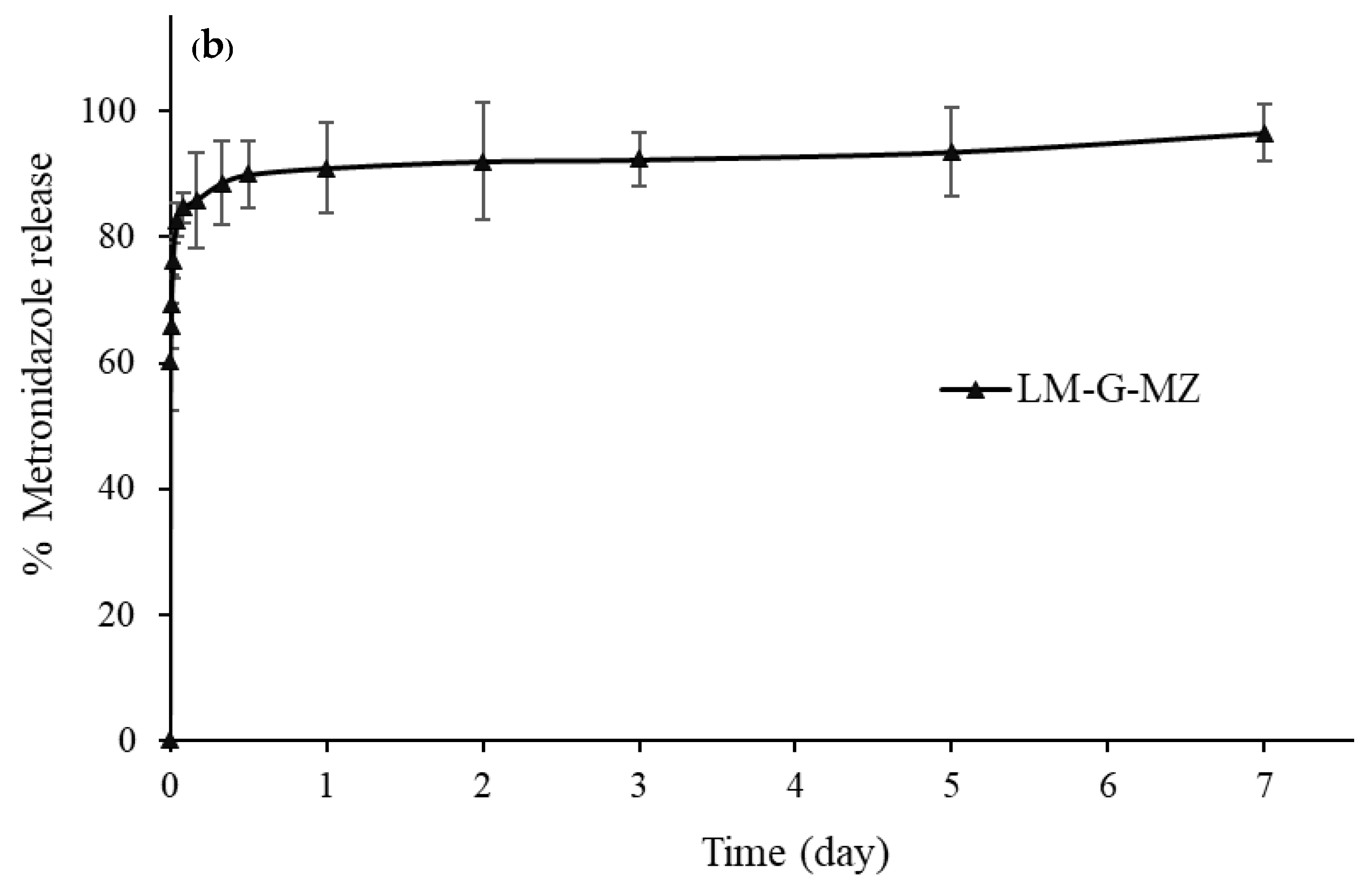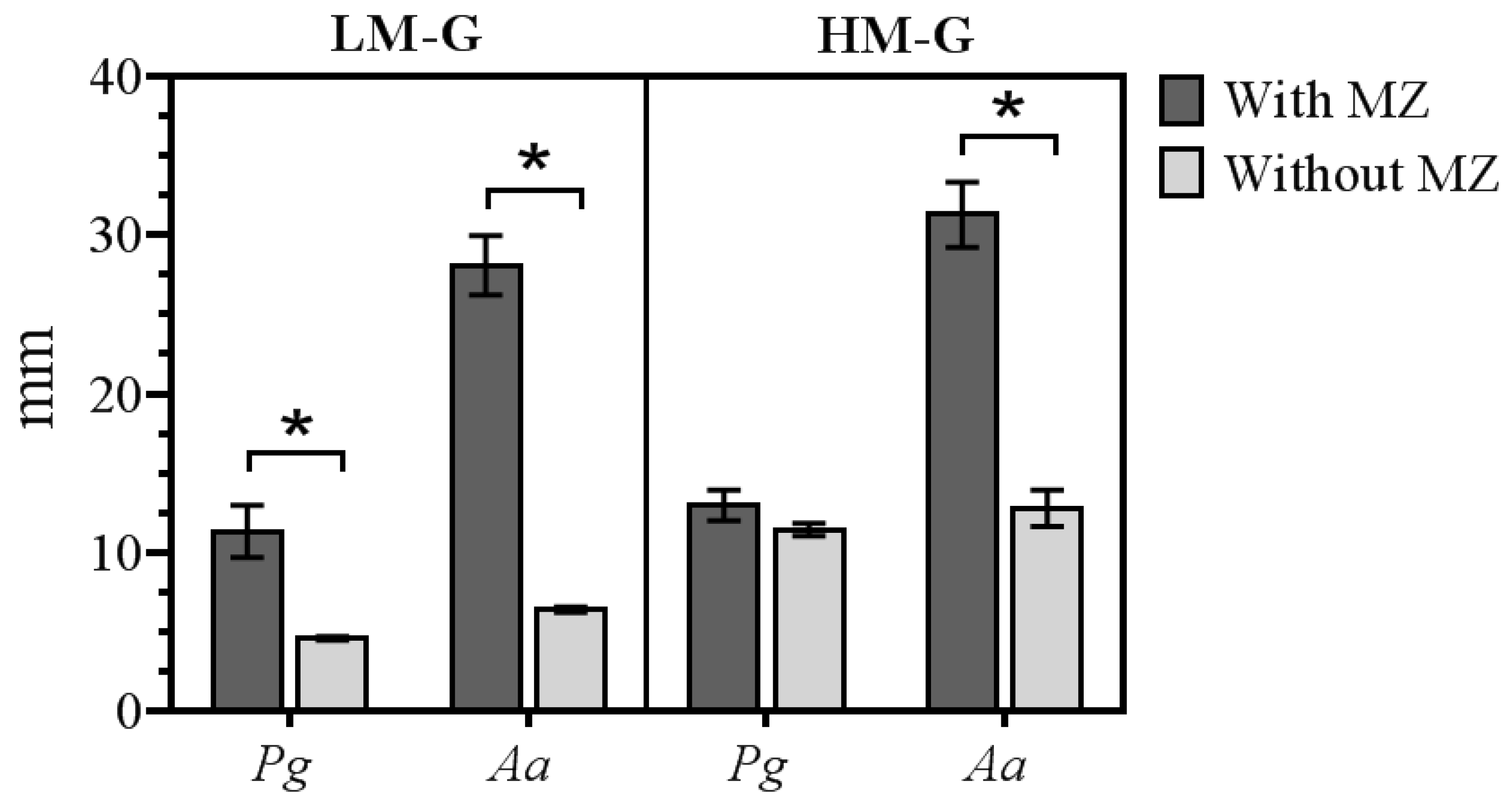Preparation and Evaluation of Metronidazole-Loaded Pectin Films for Potentially Targeting a Microbial Infection Associated with Periodontal Disease
Abstract
:1. Introduction
2. Materials and Methods
2.1. Materials
2.2. Microorganisms
2.3. Preparation of Metronidazole-Loaded Pectin Film
2.4. Film Characterizations
2.4.1. Morphological Characterization of the Films
2.4.2. Film Thickness and Weight Variation
2.4.3. Mechanical Strength Test
2.4.4. Swelling Study
2.5. Metronidazole Content
2.6. In Vitro Metronidazole Release Study
2.7. Preparation of Bacteria for Agar Diffusion Test and Anti-Bacterial Activity of Metronidazole-Loaded Pectin Film
2.8. Statistical Analysis
3. Results and Discussion
3.1. Film Preparation and Characterization
3.2. Mechanical Properties
3.3. Film Swelling Behavior
3.4. In Vitro Metronidazole Release
3.5. Anti-Bacterial Activity of Metronidazole-Loaded Pectin Film
4. Conclusions
Author Contributions
Funding
Acknowledgments
Conflicts of Interest
References
- Naorungroj, S.; Naorungroj, T. Oral health-related quality of life in the elderly: A review and future challenges in Thailand. SMJ 2015, 67, 248–253. [Google Scholar]
- Mombelli, A. Periodontitis as an infectious disease: Specific features and their implications. Oral Dis. 2003, 9, 6–10. [Google Scholar] [CrossRef] [PubMed]
- Rams, T.; Slots, J. Local delivery of antimicrobial agents in the periodontal pocket. Periodontology 1996, 10, 139–159. [Google Scholar] [CrossRef]
- Hanes, P.J.; Purvis, J.P. Local anti-infective therapy: Pharmacological agents a systematic review. Ann Periodontology 2003, 8, 79–98. [Google Scholar] [CrossRef] [PubMed]
- Pahkla, E.R.; Koppel, T.; Saag, M.; Pahkla, R. Metronidazole concentrations in plasma, saliva and periodontal pockets in patients with periodontitis. J. Clin. Periodontol. 2005, 32, 163–166. [Google Scholar] [CrossRef] [PubMed]
- Lamp, K.C.; Freeman, C.D.; Klutman, N.E.; Lacy, M.K. Pharmacokinetics and pharmacodynamics of nitroimidazole antimicrobials. Clin. Pharmacokinet. 1999, 36, 353–373. [Google Scholar] [CrossRef] [PubMed]
- Robinson, S.; Meeks, T.W.; Geniza, C. Which agents work best: FDA approved and off-label medications help patients achieve abstinence and maintain sobriety. Curr. Psychiatr. 2014, 13, 22–32. [Google Scholar]
- Wenisch, C.; Parschalk, B.; Hasenhündl, M.; Hirschl, A.M.; Graninger, W. Comparison of vancomycin, teicoplanin, metronidazole, and fusidic acid for the treatment of Clostridium difficile-associated diarrhea. Clin. Infect. Dis. 1996, 22, 813–818. [Google Scholar] [CrossRef] [PubMed]
- Zar, F.A.; Bakkanagari, S.R.; Moorthi, K.M.L.; Davis, M.B. A comparison of vancomycin and metronidazole for the treatment of Clostridium difficile-associated diarrhea, stratified by disease severity. Clin. Infect. Dis. 2007, 45, 302–307. [Google Scholar] [CrossRef] [PubMed]
- Shifrovitch, Y.; Binderman, I.; Bahar, H.; Berdicevsky, I.; Zilberman, M. Metronidazole-loaded bioabsorbable films as local antibacterial treatment of infected periodontal pockets. J. Clin. Periodontol. 2009, 80, 330–337. [Google Scholar] [CrossRef] [PubMed]
- Ahuja, A.; Ali, J.; Rachman, S. Biodegradable periodontal intrapocket device containing metronidazole and amoxicillin: Formulation and characterization. Pharmazie 2006, 61, 25–29. [Google Scholar] [PubMed]
- Jantrawut, P.; Chaiwarit, T.; Jantanasakulwong, K.; Brachais, H.C.; Chambin, O. Effect of plasticizer type on tensile property and in vitro indomethacin release of thin films based on low-methoxyl pectin. Polymers 2017, 9, 289. [Google Scholar] [CrossRef]
- Preis, M.; Knop, K.; Breitkreutz, J. Mechanical strength test for orodispersible and buccal films. Int. J. Pharm. 2014, 461, 22–29. [Google Scholar] [CrossRef] [PubMed]
- Nafee, N.A.; Boraie, M.A.; Ismail, F.A.; Mortada, L.M. Design and characterization of mucoadhesive buccal patches containing cetylpyridinium chloride. Acta Pharm. 2003, 53, 199–212. [Google Scholar] [PubMed]
- Thakur, B.R.; Singh, R.K.; Handa, A.K.; Rao, M.A. Chemistry and uses of pectin a review. Crit. Rev. Food Sci. Nutr. 1997, 37, 47–73. [Google Scholar] [CrossRef] [PubMed]
- Oh, C.M.; Heng, P.W.; Chan, L.W. Influence of hydroxypropyl methylcellulose on metronidazole crystallinity in spray-congealed polyethylene glycol microparticles and its impact with various additives on metronidazole release. Pharm. Sci. Technol. 2015, 16, 1357–1367. [Google Scholar] [CrossRef] [PubMed]
- Martino, P.D.; Censi, R.; Malaj, L.; Martelli, S.; Joiris, E.; Barthélémy, C. Influence of metronidazole particle properties on granules prepared in a high-shear mixer-granulator. Drug Dev. Ind. Pharm. 2007, 33, 121–131. [Google Scholar] [CrossRef] [PubMed]
- Espitia, P.J.P.; Du, W.X.; Avena-Bustillos, R.J.; Soares, N.F.F.; McHugh, T.H. Edible films from pectin: Physical-mechanical and antimicrobial properties. Food Hydrocoll. 2014, 35, 287–296. [Google Scholar] [CrossRef]
- Khatoon, N.; Rao, N.G.R.; Reddy, B.M. Overview on fast dissolving oral films. Int. J. Chem. Pharm. Sci. 2013, 1, 63–75. [Google Scholar]
- Coffin, D.R.; Fishman, M.L. Physical and mechanical properties of highly plasticized pectin starch films. J. Appl. Polym. Sci. 1994, 54, 1311–1320. [Google Scholar] [CrossRef]
- Sharma, B.R.; Naresh, L.; Dhuldhoya, N.C.; Merchant, S.U.; Merchant, U.C. An overview on pectins. TFPJ 2006, 44–51. [Google Scholar]
- Alonso-Mougán, M.; Meijide, F.; Jover, A.; Rodríguez-Núñez, E.; Vázquez-Tatoa, J. Rheological behaviour of an amide pectin. J. Food Eng. 2002, 55, 123–129. [Google Scholar] [CrossRef]
- Tibbits, W.; MacDougall, A.J.; Ring, S.G. Calcium binding and swelling behaviour of a high methoxyl pectin gel. Carbohydr. Res. 1998, 310, 101–107. [Google Scholar] [CrossRef]
- Alonzo, D.E.; Zhang, G.G.Z.; Zhou, D.; Gao, Y.; Taylor, L.S. Understanding the behavior of amorphous pharmaceutical systems during dissolution. Pharm. Res. 2010, 27, 608–618. [Google Scholar] [CrossRef] [PubMed]
- Nalawade, T.M.; Bhat, K.; Sogi, S.H. Bactericidal activity of propylene glycol, glycerine, polyethylene glycol 400, and polyethylene glycol 1000 against selected microorganisms. J. Int. Soc. Prev. Community Dent. 2015, 5, 114–119. [Google Scholar] [CrossRef] [PubMed]
- Consensus Report. Periodontal Diseases: Pathogenesis and Microbial Factors. Available online: https://onlinelibrary.wiley.com/doi/pdf/10.1902/annals.1996.1.1.926 (accessed on 13 September 2018).
- Torrungruang, K.; Jitpakdeebordin, S.; Charatkulangkun, O.; Gleebbua, Y. Porphyromonas gingivalis, Aggregatibacter actinomycetemcomitans, and Treponema denticola Prevotella intermedia co-infection are associated with severe periodontitis in a Thai population. PLoS ONE 2015, 10, e0136646. [Google Scholar] [CrossRef] [PubMed]
- Ardila, C.M.; Guzmán, I.C.; Bermudez, L.; Bernau, S.; Contreras, A.; Duque, A.; Duarte, S.; Avila, J.D.; Lafaurie, G.I. Porphyromonas gingivalis and Aggregatibacter actinomycetemcomitans IgG subclass antibody levels as immunological risk indicators of chronic periodontitis: A multilevel approach. Int. J. Odontostomatol. 2013, 7, 433–440. [Google Scholar] [CrossRef]





| Sample Code | LM Pectin (%) | HM Pectin (%) | Glycerin (%) | Metronidazole (%) |
|---|---|---|---|---|
| LM | 3 | - | - | - |
| LM-G | 3 | - | 40 | - |
| LM-MZ | 3 | - | - | 5 |
| LM-G-MZ | 3 | - | 40 | 5 |
| HM | - | 3 | - | - |
| HM-G | - | 3 | 40 | - |
| HM-MZ | - | 3 | - | 5 |
| HM-G-MZ | - | 3 | 40 | 5 |
| Film | Thickness (mm ± SD) | Weight (mm ± SD) |
|---|---|---|
| LM | 0.30 ± 0.02 a | 4.83 ± 0.25 a |
| LM-G | 0.36 ± 0.01 b | 5.50 ± 0.65 b |
| LM-MZ | 0.34 ± 0.02 c | 5.40 ± 0.25 b |
| LM-G-MZ | 0.37 ± 0.01 b | 6.23 ± 0.18 c |
| HM | 0.25 ± 0.04 d | 4.62 ± 0.92 a |
| HM-G | 0.35 ± 0.03 c | 6.49 ± 0.61 c |
| HM-MZ | 0.28 ± 0.03 a | 4.53 ± 0.41 a |
| HM-G-MZ | 0.37 ± 0.01 b | 6.92 ± 0.30 d |
| Film | Max. Force (N) | Displacement (mm) | Puncture Strength (N/mm2) | AUC to Peak (N·mm) |
|---|---|---|---|---|
| HM | 12.59 ± 1.19 a | 0.74 ± 0.23 a | 4.01 ± 0.38 a | 3.15 ± 0.80 a |
| HM-G | 4.31 ± 0.58 b | 1.21 ± 0.08 b | 1.37 ± 0.19 b | 2.26 ± 0.29 b |
| HM-MZ | 12.81 ± 1.07 a | 0.70 ± 0.03 a | 4.08 ± 0.34 a | 3.33 ± 0.36 a |
| HM-G-MZ | 2.65 ± 0.08 c | 1.15 ± 0.01 c | 0.84 ± 0.03 c | 1.24 ± 0.08 c |
| LM | 10.24 ± 1.50 d | 1.13 ± 0.02 c | 3.26 ± 0.48 d | 3.63 ± 0.49 a |
| LM-G | 6.44 ± 0.09 b | 1.02 ± 0.05 d | 2.05 ± 0.03 e | 2.24 ± 0.14 b |
| LM-MZ | 14.09 ± 0.69 e | 1.16 ± 0.08 c | 4.48 ± 0.22 a | 4.84 ± 0.41 d |
| LM-G-MZ | 5.13 ± 1.16 b | 1.06 ± 0.08 d | 1.63 ± 0.37 b | 2.08 ± 0.25 b |
© 2018 by the authors. Licensee MDPI, Basel, Switzerland. This article is an open access article distributed under the terms and conditions of the Creative Commons Attribution (CC BY) license (http://creativecommons.org/licenses/by/4.0/).
Share and Cite
Junmahasathien, T.; Panraksa, P.; Protiarn, P.; Hormdee, D.; Noisombut, R.; Kantrong, N.; Jantrawut, P. Preparation and Evaluation of Metronidazole-Loaded Pectin Films for Potentially Targeting a Microbial Infection Associated with Periodontal Disease. Polymers 2018, 10, 1021. https://doi.org/10.3390/polym10091021
Junmahasathien T, Panraksa P, Protiarn P, Hormdee D, Noisombut R, Kantrong N, Jantrawut P. Preparation and Evaluation of Metronidazole-Loaded Pectin Films for Potentially Targeting a Microbial Infection Associated with Periodontal Disease. Polymers. 2018; 10(9):1021. https://doi.org/10.3390/polym10091021
Chicago/Turabian StyleJunmahasathien, Taepin, Pattaraporn Panraksa, Paytaai Protiarn, Doosadee Hormdee, Rajda Noisombut, Nutthapong Kantrong, and Pensak Jantrawut. 2018. "Preparation and Evaluation of Metronidazole-Loaded Pectin Films for Potentially Targeting a Microbial Infection Associated with Periodontal Disease" Polymers 10, no. 9: 1021. https://doi.org/10.3390/polym10091021






